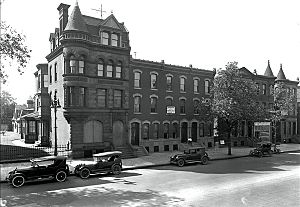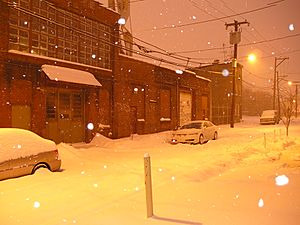North Philadelphia facts for kids
Quick facts for kids
North Philadelphia
|
|
|---|---|
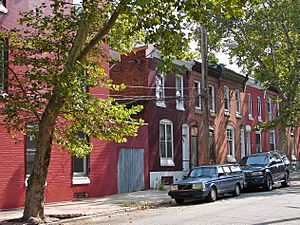
Brewerytown Historic District in North Philadelphia.
|
|
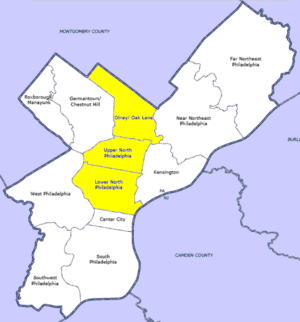
Map of Philadelphia County with North Philadelphia highlighted. Click for larger image
|
|
| Country | |
| State | |
| County | |
| City | |
| Area | |
| • Total | 46.7 sq mi (121 km2) |
| Population
(2010)
|
|
| • Total | 240,781 |
| • Density | 5,155/sq mi (1,990/km2) |
| ZIP code |
19120, 19121, 19122, 19123, 19125, 19126, 19130, 19132, 19133, 19134, 19137, 19138, 19140, 19141, 19150
|
North Philadelphia, often called North Philly, is a large part of Philadelphia, Pennsylvania, in the United States. It is located just north of Center City. North Philadelphia generally includes everything north of Vine Street or Spring Garden Street. It is found between Northwest Philadelphia and Northeast Philadelphia.
The area is bordered by Cheltenham Township to the north along Cheltenham Avenue. Spring Garden Street forms its southern border. To the west is 35th Street, and Adams Avenue is its eastern border. North Philadelphia includes many ZIP codes, such as 19120, 19121, and 19122. The city government sees this big area as three smaller districts. These are Olney-Oak Lane, Upper North Philadelphia, and Lower North Philadelphia. Many neighborhoods make up North Philadelphia. Some of these are Brewerytown, Fairhill, and Northern Liberties.
Contents
History of North Philadelphia
Early Growth of the Area
Before it became part of Philadelphia, North Philadelphia was mostly farmland. In the 1700s, Philadelphia grew very quickly. North Philadelphia became a popular place for people to live outside the busy city. Rich Philadelphians built large homes there. By the early 1800s, small towns had grown up to support the increasing population.
However, this changed in the mid-1800s. A state law called The Consolidation Act of 1854 brought all the townships in Philadelphia County into the City of Philadelphia. With more land and many new immigrants arriving, North Philadelphia stopped being a suburb. Its separate towns slowly became one large area filled with rowhomes. Many new neighborhoods kept the names of their original towns. For example, Northern Liberties was once Northern Liberties Township.
The Industrial Age
Philadelphia was a major manufacturing center from the mid-1800s to the mid-1900s. North Philadelphia was greatly shaped by this industrial period. Its buildings and layout still show this history.
As the industrial age reached its peak, North Philadelphia became a place for working people. Areas like Upper North Philadelphia and Brewerytown became important centers for making goods. Huge factories were built, covering large parts of the city. Thousands of rowhomes were built for the many workers. This growth also led to the building of the Broad Street Line subway. It was designed to take people from Olney in the north to Philadelphia City Hall quickly.
Major train lines were also built, meeting at the new North Broad Street Station. This helped move goods from the busy factories. For a time, North Philadelphia Station was the second busiest train station in the city. The Olney Avenue subway stop was the most used subway stop.
Wealthy factory owners also built their homes near their businesses. Lower North Philadelphia became home to many new rich people. These were often immigrants or those who had started successful factories. Many were German Jews who built companies and synagogues in the area. For a short time, North Philadelphia saw a period of grand buildings and fancy living. This was especially true along what is now the Historic North Broad Street Mansion District. Upscale restaurants and shops also grew in this southern part of the area. However, this wealth did not last.
Changes After the Industrial Era
Over the next few decades, events like The Great Depression and factories moving away caused big changes in North Philadelphia. Many white residents moved out of the city. This was similar to what happened in other large U.S. cities in the mid to late 1900s.
During the 1940s and 1950s, many areas became racially mixed. But smaller streets often had only black or white residents. White residents began to move out slowly in the late 1940s. They moved to newer homes in places like Northeast Philadelphia that had lawns and modern features. As more African Americans moved into vacant houses, many white residents moved away more quickly. People moved not just for newer homes, but also because property values were decreasing.
For a while, Lower North Philadelphia became a major center for black culture and music, especially Jazz. Many famous musicians, like John Coltrane, came to North Philadelphia. By 1964, North Philadelphia was the city's main center for African American culture. It was home to 400,000 of the city's 600,000 Black residents.
As the century continued, other problems common to U.S. cities appeared. Many neighborhoods in North Philadelphia depended on one large factory for jobs. When a factory closed, it greatly harmed the community. This led to many "factory neighborhoods" breaking apart in working-class North Philadelphia.
The 1964 Columbia Avenue Incident
On August 28, 1964, an argument happened between a black woman, Odessa Bradford, and two police officers. This took place at 23rd Street and Columbia Avenue. Rumors spread that a pregnant black woman had been badly hurt by white police officers. Later that evening and for the next two days, angry crowds damaged and burned businesses. These were mostly white-owned businesses along Columbia Avenue.
This event showed the growing tensions in the area. It also led to more white residents moving away. The damage to the main shopping area of North Philadelphia marked the start of a decline for the area's businesses. As American manufacturing declined, many factories closed. This affected the neighborhoods that relied on them. Even strong black communities in North Philadelphia faced challenges. Famous places like Connie Mack Stadium closed. The BSL subway line gained a reputation for safety concerns. Many beautiful art deco buildings were left empty.
Location of North Philadelphia
 |
Cheltenham Township | Cheltenham Township | Northeast Philadelphia |  |
| Germantown, Chestnut Hill | Kensington | |||
| West Philadelphia | Center City | Camden County, New Jersey |
North Philadelphia Today
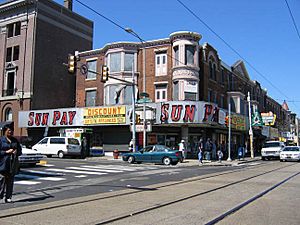
Neighborhoods and Diversity
North Philadelphia has many different neighborhoods. Like other parts of Philadelphia, different blocks can have different racial and social groups. In the southern part of North Philadelphia, Germantown Avenue (which becomes North 6th Street) often divides areas. West of this street, areas are mostly Black. East of it, areas are mostly Hispanic. This is slowly changing, with more mixing of groups.
The area between Broad Street and 5th Street is becoming a "transition zone." It has almost equal numbers of Hispanic and Black residents. East of Front Street, neighborhoods become even more diverse. They have significant populations of Hispanic, Black, and White residents.
North Philadelphia is generally described as the area north of Center City. It lies between Front Street and Fairmount Park.
The main sub-sections are:
- Lower North Philadelphia - from Spring Garden Street to Dauphin Street.
- Upper North Philadelphia - from Dauphin Street to Wyoming Avenue.
- Olney-Oak Lane, Philadelphia (also called Uptown) - from Wyoming Avenue to the Philadelphia city limits.
Old Buildings and New Plans
Today, many signs of North Philadelphia's richer past remain. However, many historic buildings have fallen apart or been torn down. Thousands more are empty. Some have been protected as historic sites. 67 properties and districts are now on the National Landmark of Historic Places. Many grand churches were built over the years. Some are still standing, but it can be hard to find money to fix them.
Large, empty factories and warehouses are common sights. Old train lines that are no longer used also mark the landscape. The names of old factory owners, like Gratz and Schmidt, are still on buildings and street signs. But many people today do not know who they were.
The Neighborhood Transformation Initiative, or NTI, was a city program. It was started by Mayor John F. Street. This program aimed to tear down thousands of old buildings. It also planned to build new public housing. Some people believe the program did not try hard enough to save historic buildings. Others felt NTI was necessary to improve troubled neighborhoods. The long-term effects of this program are still being seen.
Famous People from North Philadelphia
Many notable people have come from North Philadelphia.
New Growth and Changes
Some areas, like Olney and Allegheny, still have active communities. However, they often face challenges. Pep Boys, a large company, has its main office in Allegheny West. This has helped that neighborhood.
Parts of North Philadelphia, especially those near Center City, are seeing new development. Neighborhoods like Brewerytown and Northern Liberties are getting new buildings. Other areas have not changed much, except for rising housing prices. Some residents are worried about these changes. They feel that new investments threaten the traditional feel of their neighborhoods. Some poorer and older residents have been forced to move out. This is because rising property values make it hard for them to stay. Many fear this process will continue in North Philadelphia.
Population and People
According to the 2010 census, over 340,000 people live in certain ZIP codes of North Philadelphia.
Most of North Philadelphia's population is made up of African Americans and Puerto Ricans. The eastern part of North Philadelphia has one of the largest groups of Puerto Ricans in the country. This section is over 75% Puerto Rican. More than half of all Puerto Ricans in Philadelphia live here. North Philadelphia also has many Black Muslims. The area also has groups of Irish, Dominican, Haitian, Cuban, Korean, and Polish people. About half of the population lives below the poverty line.
Getting Around North Philadelphia
Broad Street runs through the middle of North Philadelphia from north to south. It is a major street with six lanes. The Broad Street Line subway, also called the 'Orange Line,' runs along Broad Street. It connects North Philadelphia directly to Center City and South Philadelphia. It also links to the rest of Philadelphia's public transportation system, SEPTA.
As of 2017, China Airlines offers a private bus service. This bus takes customers from the Philadelphia area to John F. Kennedy International Airport in New York City. This service has a stop in North Philadelphia.
Economy and Jobs
Pep Boys has its main office in North Philadelphia.
Some parts of North Philadelphia used to be very busy with businesses. For example, TOPPS Cards were once made here.
Temple University is one of the largest employers in Philadelphia. Temple University Hospital is also a major employer.
Education in North Philadelphia
Public Schools
Public and Charter schools in North Philadelphia are managed by the School District of Philadelphia. The area is divided into "clusters" that oversee individual schools.
Some schools in the area include:
- William Penn (William Penn High School closed in 2010)
- Strawberry Mansion
- Murrell Dobbins C.T.E.
- A. Philip Randolph C.T.E.
- Masterman
- Gratz (now a Mastery Charter School)
- Edison
- King
- Olney
- Central
- Philadelphia High School for Girls ("Girls High")
The Mastery Charter Schools system also runs the Clymer School in North Philadelphia. North Philadelphia has the largest number of Charter Schools in Philadelphia.
Colleges and Universities
North Philadelphia is home to several colleges and universities.
- La Salle University
- Community College of Philadelphia
- Messiah College, Philadelphia Campus
- Temple University
- Harcum College at Congreso.
Libraries
There are thirteen branch libraries of the Philadelphia Free Library in North Philadelphia.
Museums and Cultural Places
North Philadelphia has several interesting museums and cultural sites.
- Church of the Advocate
- Philadelphia Doll Museum
- Wagner Free Institute of Science
- The Blue Horizon (now closed)
- The Village of Arts and Humanities
The Uptown Theater is a very important part of North Philadelphia's music history. Many famous artists started their careers there.
|


